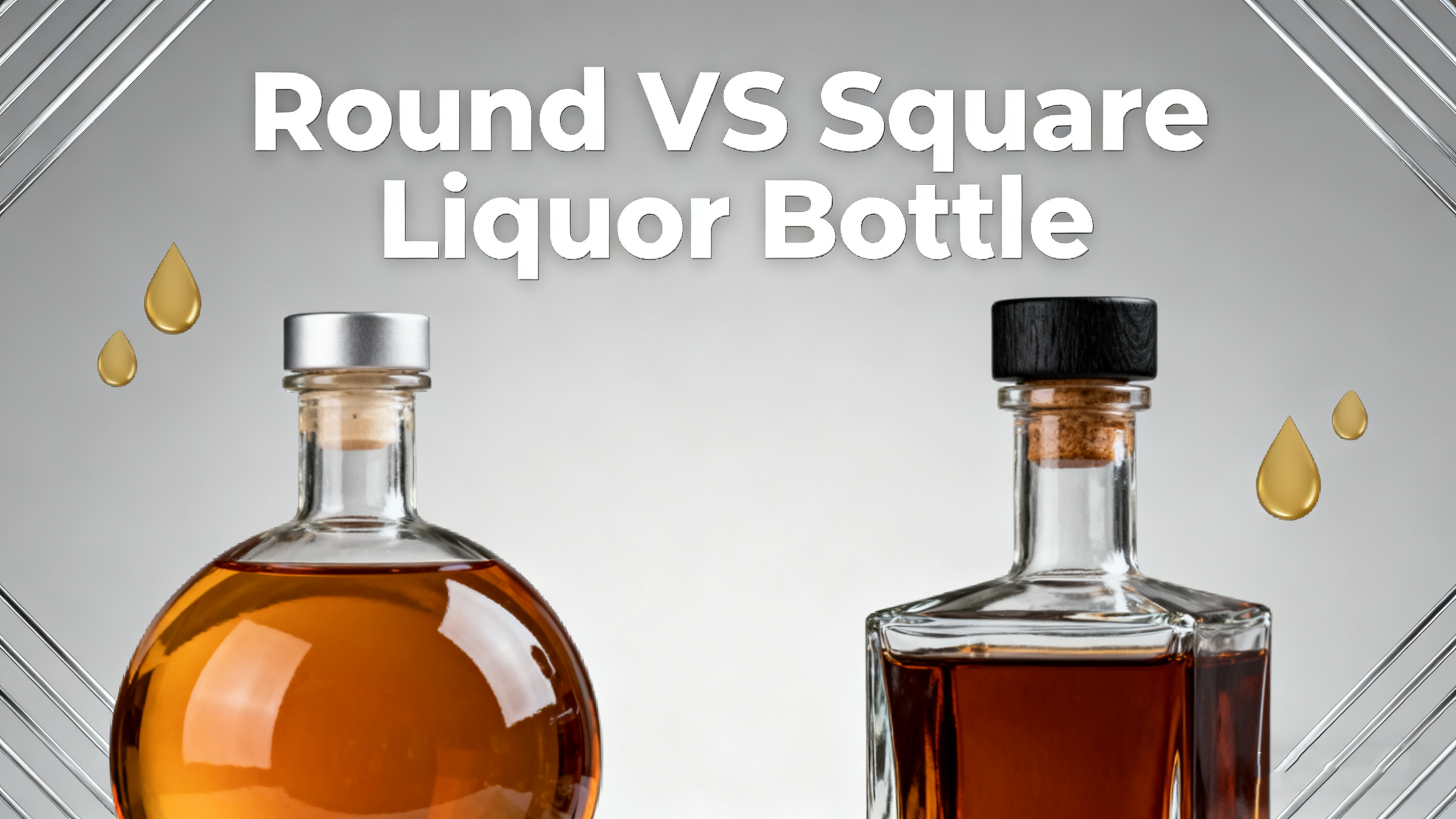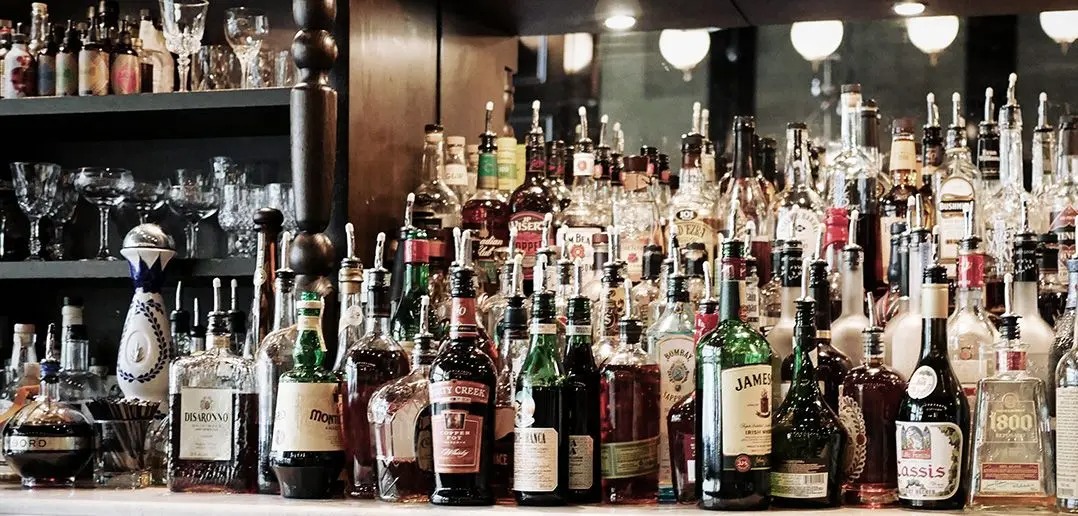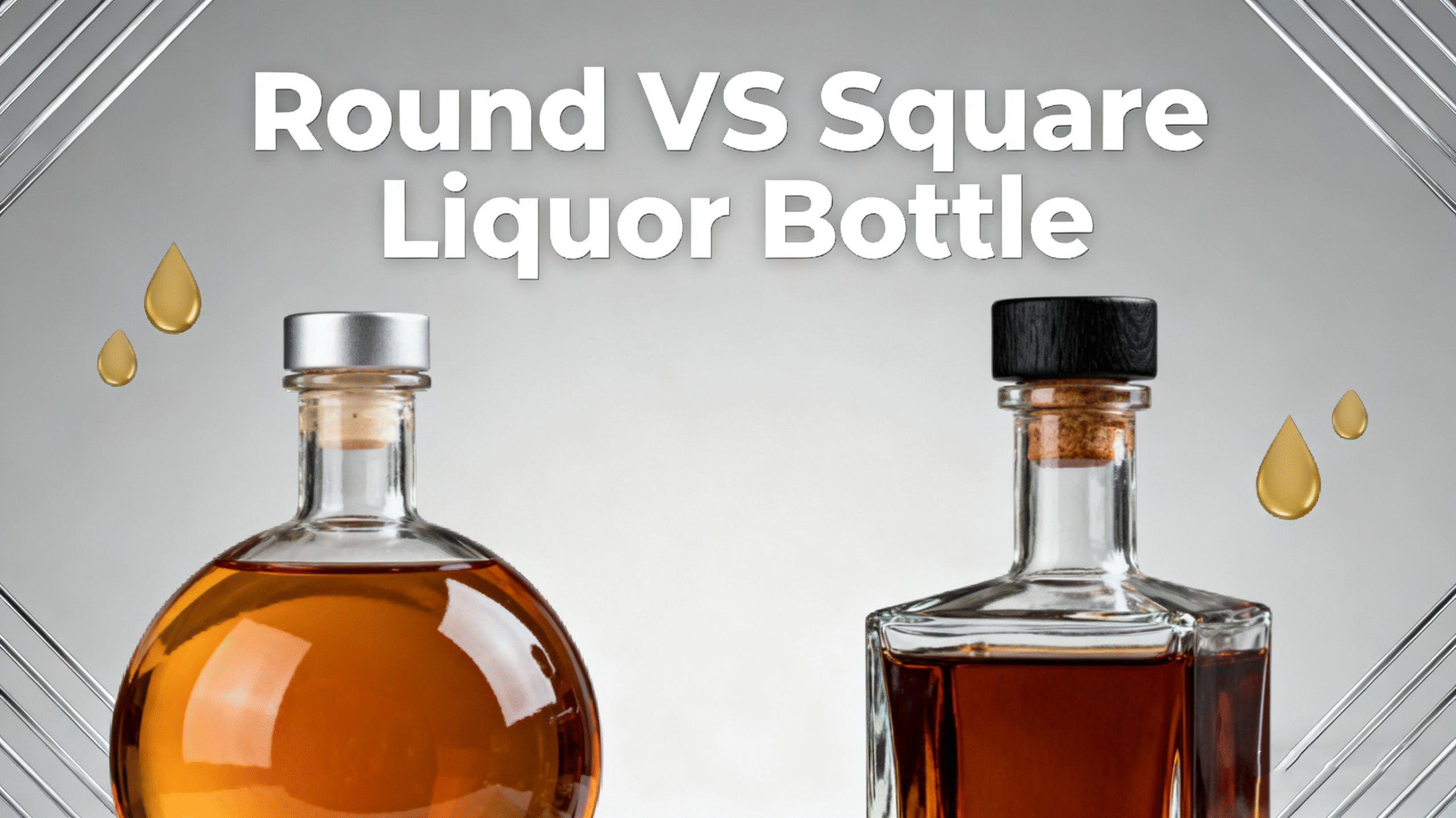
The design of a Liquor Bottle serves multiple purposes: it must protect its contents, facilitate easy pouring, and stand out on a crowded shelf. This has led to the prevalence of two main silhouettes—the round bottle and the square bottle. Each shape carries its own set of ergonomic, economic, and marketing implications. We’re going to slowly explore how these two fundamental forms compare across various practical considerations.
Table of Contents
Why Liquor Bottle Shape is More Than Just Looks
At first glance, the shape of a liquor bottle might seem like a simple aesthetic choice. But look closer, and you’ll find it’s a crucial piece of the puzzle that influences what we buy, how a brand is perceived, and even how a bottle is used behind a bar.
Speaking to the Consumer
Before a bottle is even picked up, its shape is already telling a story. A tall, slender silhouette often suggests elegance and sophistication, while a stout, square bottle can convey a sense of tradition and reliability. This first impression is powerful. In fact, a bottle’s visual appeal is a key driver in a significant majority of purchasing decisions. A distinctive design can even lead consumers to perceive the spirit inside as higher quality and justify a higher price point.
Building a Brand Identity
In a crowded market, a unique bottle shape is a powerful tool for standing out. An iconic design, like the Hennessy XO bottle shaped like an inverted grape cluster, becomes inseparable from the brand itself. Beyond standing out, the general form—whether round and modern or square and classic—helps to instantly communicate a brand’s personality.
Designed for Real-World Use
A bottle isn’t just a vessel for display; it needs to function. This is especially true in a busy bar environment. Curved bottles are generally easier for bartenders to grip and pour from quickly, a small but vital detail for efficiency. While decorative “top-shelf” bottles exist, even they must balance artistry with basic ergonomics.
A Nod to Culture and Commerce
Bottle shapes can also hint at a spirit’s heritage. We often see playful, curved bottles for rum, clear and simple designs for vodka, and sturdy, weighty bottles for whiskey, each subtly reinforcing their cultural roots. From a business perspective, the right shape can also streamline logistics and reduce shipping costs, proving that good design is as much about smart business as it is about good looks.
Cost Analysis: Square vs. Round Liquor Bottles
When it comes to liquor packaging, the choice between a square or round bottle isn’t just about style—it has real financial implications. From material use to shipping, each shape carries a different cost structure that influences both production budgets and final retail prices.
Material & Manufacturing Expenses
Square bottles require significantly more glass—up to 15% more than a round bottle of the same volume. That extra material not only increases weight but also drives up raw material costs. To prevent breakage, the corners need to be thicker, adding further to the glass used.
Mold costs tell a similar story. Square bottle molds can be 10–30% more expensive due to the complexity of shaping sharp corners and ensuring even temperature control during production. Round bottles, with their simpler design, are easier and faster to manufacture, leading to fewer defects and less downtime.
Durability & Shipping
Square bottles are more fragile at the edges, which often means higher inspection rates and more waste. While their flat sides allow tighter stacking—improving transport efficiency by 5–10%—the weight penalty usually cancels out this benefit. Shipping square bottles can cost up to 20% more due to their extra mass.
Round bottles, though less space-efficient in boxes, are lighter and structurally stronger. Their curved walls distribute stress evenly, reducing the risk of breakage during transit.
Branding Flexibility & Scale Impact
Square bottles offer a straightforward advantage when it comes to labeling: their flat panels make applying large labels or embossed designs easier on automated lines. However, this comes at the expense of design versatility.
Round bottles allow for creative wraparound labels and tend to be more cost-effective at high volumes, where mold and setup costs are spread across thousands of units. Small custom runs using square shapes, on the other hand, come with a noticeably higher per-bottle cost.
Factor | Square Bottle | Round Bottle |
|---|---|---|
Glass Used | +15% | Baseline |
Mold Cost | +10–30% | Lower |
Shipping Cost | +20% minus 5–10% stacking savings | Lower, less stacking gain |
Fragility/Durability | Thicker glass required | Even weight distribution |
Design/Labeling | Easy labeling, less creative | Wraparound, more flexibility |
Retail Price Impact | Higher shelf/collector’s prices | Lower, mass-market option |
Real-World Example: Jack Daniel’s
A clear example of the square bottle’s premium positioning is the Jack Daniel’s design. The brand opts for a square bottle, accepting higher costs related to specialized molds and thicker glass to achieve a distinctive, sturdy look that supports its brand identity.
The Bottom Line
While square bottles help communicate a premium image and offer practical labeling benefits, they come with higher material, mold, and shipping costs. Round bottles remain the go-to for cost-sensitive, high-volume production, offering efficiency, lighter weight, and greater design flexibility.

Durability & Breakage Risk: Round vs. Square Liquor Bottles
When it comes to durability, the shape of a liquor bottle isn’t just about looks—it directly affects how well the bottle holds up under pressure, both on the shelf and in transit.
Structural Strength: The Round Advantage
Round bottles are naturally more resilient. Their curved design evenly distributes impact, which helps prevent cracks and chips even when they’re jostled or knocked over. This structural strength means they often require less protective packaging, making them a reliable and cost-effective option for high-volume environments like bars or busy retail stores.
Square bottles, by contrast, face a built-in challenge: their corners act as weak points. In fact, industry estimates suggest that up to 60% of breakages in square bottles occur along the edges. To compensate, manufacturers often use glass that’s 1.5 to 2 times thicker than that used in round bottles. While this reduces the risk, it doesn’t eliminate it—and it adds both weight and cost.
Handling & Real-World Performance
Square bottles do stack neatly, which helps maximize shelf and storage space. But this advantage comes with a trade-off: they’re more susceptible to chipping or cracking when dropped, often requiring additional protective packaging during shipping.
Round bottles may not stack as compactly, but their shape naturally absorbs shocks and impacts. This makes them easier and safer to handle in fast-paced settings, with less need for extra padding or reinforcement.
A good example is the Johnnie Walker square whisky bottle—a design that’s become iconic. Despite added reinforcement at the edges, it remains more prone to corner breakage compared to round bottles of similar volume.
All things considered, round bottles tend to be the more durable and break-resistant option. They perform better under stress, require less material to achieve strength, and help keep packaging costs down. Square bottles offer aesthetic and stacking benefits but come with higher fragility and often require extra investment in glass thickness and protective packaging to perform safely.
Market Positioning & Use Cases: Who Chooses Round vs. Square?
In the world of spirits, a bottle’s shape does more than hold liquid—it communicates a brand’s identity and targets a specific audience. Round and square bottles have carved out distinct roles in the market, each appealing to different consumers and use cases.
Round Bottles: The Classic Choice
Round bottles continue to dominate the spirits market, holding over half of global production. They are the go-to for brands that emphasize heritage, authenticity, and timeless appeal. Think of traditional whisky brands like Jameson or the iconic Absolut Vodka—their round shapes feel familiar and reliable, both in the hand and on the shelf.
These bottles are especially well-suited for bars and restaurants, where comfort and pouring performance matter. However, their curved shape makes them less space-efficient when stacked, and they offer less room for bold branding compared to flat-panel designs.
Square Bottles: Modern & Memorable
Square bottles are often chosen by brands looking to stand out. Their clean lines and flat surfaces create a contemporary, premium impression that resonates with design-conscious or younger consumers. Notable examples include Johnnie Walker and Jack Daniel’s, whose square bottles are instantly recognizable and optimized for visual impact.
This shape excels in retail and gifting contexts, where shelf presence and efficient stacking are advantages. The flat sides also serve as a canvas for creative labeling and embossing. That said, square bottles come with trade-offs: they generally cost more to produce, use more material, and are more vulnerable to damage at the corners.
Bottle Shape | Positioning | Use Cases | Target Market | Standout Feature |
|---|---|---|---|---|
Round | Classic, reliable | Heritage, bar use, premium tradition | Traditional, legacy consumer base | Comfort, familiarity |
Square | Modern, premium, bold | Gifting, shelf standout, efficient logistics | Design-focused, premium-seeking market | Brand differentiation |
The Strategic Takeaway
Ultimately, the choice between round and square often comes down to brand story and audience. Round bottles support a narrative of tradition and reliability, while square bottles help a brand signal innovation and premium positioning. Understanding these associations can make all the difference in reaching the right customer—whether they’re looking for a timeless classic or a bold new expression.

Conclusion: Choosing Your Perfect Shape
In the end, the choice between a round and square liquor bottle is a strategic decision that balances cost, functionality, and brand storytelling. Round bottles offer classic appeal, production efficiency, and superior durability, while square bottles provide a modern, distinctive shelf presence and excellent stacking, albeit at a higher cost.
No matter which direction you choose, the success of your packaging hinges on the quality and precision of the manufacturer behind it. At TP Glass Bottle Manufacturer, we specialize in crafting both high-performance round and eye-catching square bottles. With our expertise in glass manufacturing, we help brands navigate these very considerations, delivering custom solutions that are not only beautiful but also cost-effective and designed for real-world performance.
Ready to bottle your vision? Let’s discuss how we can bring your brand’s unique story to life with the perfect glass bottle.

